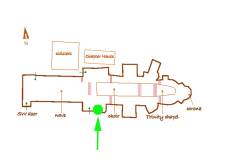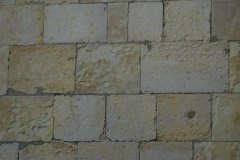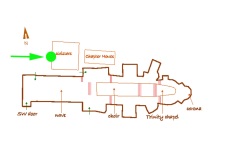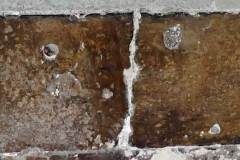Description for Fabric
Geology: fine-grained limestone
Age: Middle Jurassic
Provenance: Caen, Calvados and Orne departments
Where to see examples:
in external nave south wall (see below)
in main cloisters (see below)
For Memorials
For stone details click here
Where to see examples:
- Archbishop Langton (died 1228)
- Archbishop Meopham (died 1333)
- Archbishop Sudbury (died 1381)
- Lady Mohun (died 1404)
- Archbishop Bourchier (died 1486)
Caen Stone has been the principal building stone for Canterbury Cathedral since the major rebuilding that started in 1070 under Archbishop Lanfranc. This creamy, honey-coloured stone was quarried from numerous quarries in and around the town of Caen in Normandy, France. The early quarries were close to the River Orne where sea-going vessels could be laden with stone to make the crossing of the English Channel. As quarrying continued into the valley sides the cost to remove the unwanted overlying stone became too great to extract by open cast methods. Consequently much of the stone was quarried underground, at first by driving slightly inclined tunnels into the hillside. Today there are about 200 acres of underground galleries beneath Caen from which building stone has been extracted.
Following the Norman Conquest many of England’s medieval castles (e.g. Tower of London and Rochester), churches and monasteries (e.g. Westminster, Chichester, Durham and Norwich) were built using Caen Stone and buildings in England were to remain the largest user of Caen Stone up until the eighteenth century. It has been estimated that some 11 million cubic metres of stone has been quarried or mined from within the town’s boundary.
Caen stone is a marine limestone composed almost entirely of fine carbonate mud set in a crystalline calcite cement. Fossils and other distinguishing features are few making the stone a good freestone, one that can be laid in any orientation without unduly influencing the stone’s likelihood to decay. The uniform texture of the stone also makes it an excellent medium for sculptural work and consequently is popular with masons.
When it was decided to rebuild the north-west tower in the early nineteenth century permission was sought from the Commissioners of Customs to import Caen Stone to Canterbury, the first time since the monastery was dissolved. Unfortunately the stone (from an unknown quarry and unknown bed) was to prove to be of inferior quality. After only 30 years much of the new stonework required repair. The eminent Victorian architect Ewan Christian, following an inspection of the cathedral in 1861, found that “Decay has already commenced in the stone at the base and other parts of the Tower, but it has not proceeded so far as to be incapable of remedy by external applications which ought nevertheless to be speedily applied”.
In 2004 a quarry was opened in Cintheaux, located about 15 km south of Caen, to extract beds of limestone of the same characteristics and age as the medieval stone previously quarried in Caen. The quarry was opened to meet the demands for historic restoration projects in both France and England. Today quarrying takes place underground at Cintheaux and large square blocks are brought to the surface to be worked on within the quarry’s own workshops or to await despatch. Canterbury Cathedral has been using Caen Stone from Cintheaux Quarry since 2007. Heather Newton, the Head of Conservation at the cathedral, has stated of the new Caen Stone: “It will ensure an excellent match with much of the original stonework that remains within the cathedral.”
Caen Stone can also be seen in the west walk of the main cloisters.
Click on each image below to expand and read the caption
On the west walk of the cloisters, Caen Stone (discoloured with use and time) can be seen mixed with Reigate Stone.




